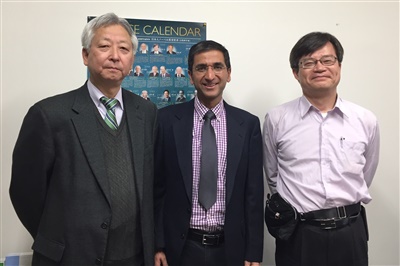-
From Blue Light to Green Power
From Blue Light to Green Power
Sandeep Bahl
Whizzing across the Japanese countryside at 300kph, my colleague Tomomasa Emoto and I arrived at Nagoya station by Shinkansen. Nagoya is home to famous Shintō shrines and castles, but that is not why we were there. We had the pleasure of visiting Professor Hiroshi Amano at Nagoya University. Amano-sensei won the 2014 Nobel Prize in physics, along with Isamu Akasaki and Shuji Nakamura, for the invention of efficient blue light-emitting diodes (LEDs). Their invention has enabled bright and energy-saving white-light sources.
Once at Nagoya University, we made our way to Amano-sensei’s office. At the entrance to the wing, we exchanged our shoes for clean slippers; I’m told this is quite typical in Japan. Amano-sensei warmly greeted us and welcomed us into his office, and we had the pleasure of hearing the perspectives of a Nobel Prize winner on gallium nitride (GaN).
 Figure 1 Texas Instruments’ Tomomasa
Emoto, Left, and Sandeep Bahl, Center, Pose with Professor Hiroshi Amano While
Visiting Nagoya University
Figure 1 Texas Instruments’ Tomomasa
Emoto, Left, and Sandeep Bahl, Center, Pose with Professor Hiroshi Amano While
Visiting Nagoya UniversityWhile many of us are working to establish the “present” of GaN, Amano-sensei is working to define the future. Now with GaN LED work in good industrial hands, he has taken on a new challenge: how to unlock the full potential of the material. Today’s commercial GaN, he explained, is not perfect, and it is difficult to grow thick material. As a result, devices can only harness about a third of their high-field capability. By focusing on inexpensive ways to grow high-quality bulk material and by looking at different structures, it is possible to make devices that operate closer to the material limit. These devices will not only be smaller but also higher voltage. Silicon carbide will have a hard time competing against GaN, he explained, when low-cost high-quality bulk GaN growth becomes available.
GaN wasn’t always this popular. I was interested to know how Amano-sensei had the insight to work on GaN at a time when the world had given up on it, so I asked. “The world needed a blue LED,” he explained, “and most people were working on zinc selenide. I did not like it, because it was very brittle. I could drop GaN and nothing would happen, so I knew it would be more stable.”
As we left, slipping our shoes back on, I was glad to know that a Nobel Prize winner is thinking about the future of GaN devices. I can now go back to my world of working towards a more energy-efficient future, where I make sure that TI GaN devices, such as the LMG3410, operate reliably under actual-use conditions.
Additional Resources:
- Learn more about GaN reliability with other posts by Sandeep:
- Let’s GaN together, reliably
- How is GaN reliability being measured for application relevance?
- A comprehensive methodology to qualify the reliability of GaN products
- APEC 2016: Application-relevant Qualification of Emerging Semiconductor Power Devices
- IEEE International Reliability Physics Symposium 2016 (Invited paper): Product-level Reliability of GaN Devices
IMPORTANT NOTICE AND DISCLAIMER
TI PROVIDES TECHNICAL AND RELIABILITY DATA (INCLUDING DATASHEETS), DESIGN RESOURCES (INCLUDING REFERENCE DESIGNS), APPLICATION OR OTHER DESIGN ADVICE, WEB TOOLS, SAFETY INFORMATION, AND OTHER RESOURCES “AS IS” AND WITH ALL FAULTS, AND DISCLAIMS ALL WARRANTIES, EXPRESS AND IMPLIED, INCLUDING WITHOUT LIMITATION ANY IMPLIED WARRANTIES OF MERCHANTABILITY, FITNESS FOR A PARTICULAR PURPOSE OR NON-INFRINGEMENT OF THIRD PARTY INTELLECTUAL PROPERTY RIGHTS.
These resources are intended for skilled developers designing with TI products. You are solely responsible for (1) selecting the appropriate TI products for your application, (2) designing, validating and testing your application, and (3) ensuring your application meets applicable standards, and any other safety, security, or other requirements. These resources are subject to change without notice. TI grants you permission to use these resources only for development of an application that uses the TI products described in the resource. Other reproduction and display of these resources is prohibited. No license is granted to any other TI intellectual property right or to any third party intellectual property right. TI disclaims responsibility for, and you will fully indemnify TI and its representatives against, any claims, damages, costs, losses, and liabilities arising out of your use of these resources.
TI’s products are provided subject to TI’s Terms of Sale (www.ti.com/legal/termsofsale.html) or other applicable terms available either on ti.com or provided in conjunction with such TI products. TI’s provision of these resources does not expand or otherwise alter TI’s applicable warranties or warranty disclaimers for TI products.
Mailing Address: Texas Instruments, Post Office Box 655303, Dallas, Texas 75265
Copyright © 2023, Texas Instruments Incorporated